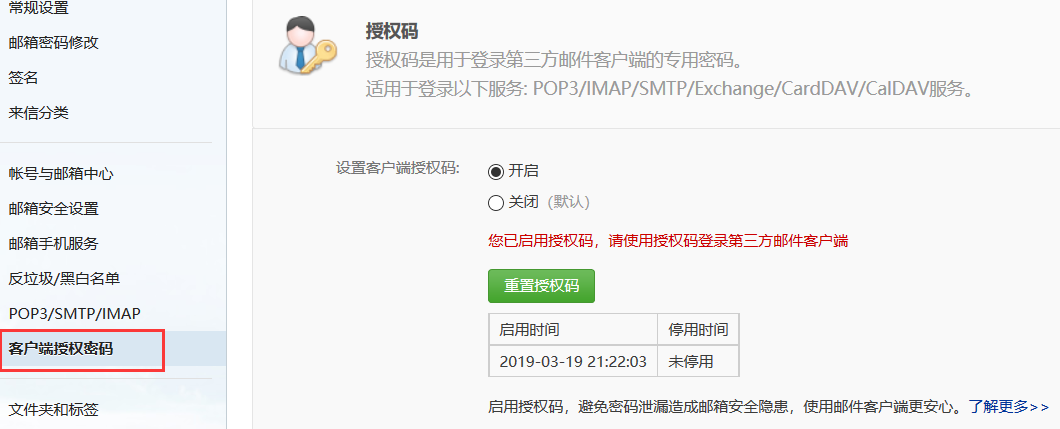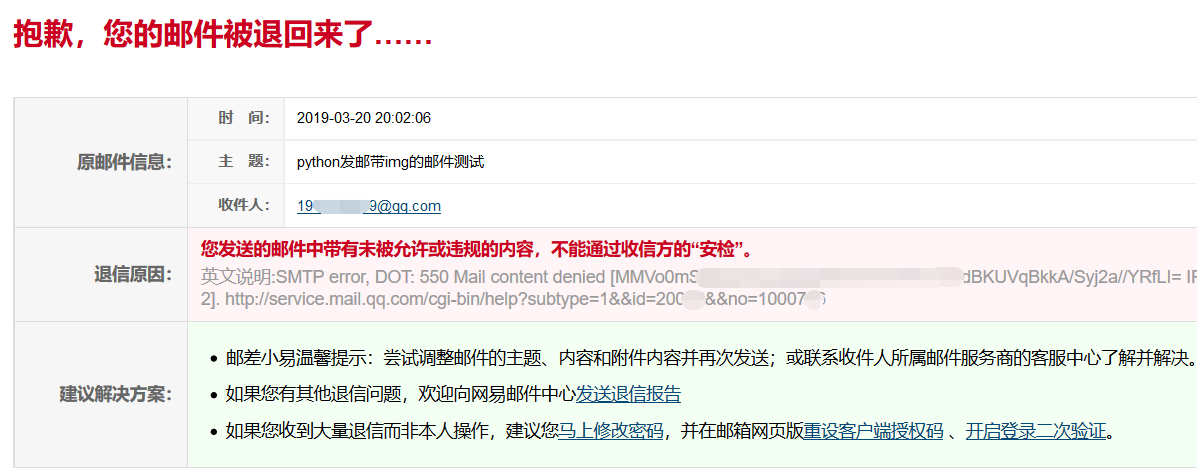3.python 发送邮件之smtplib模块
SMTP(Simple Mail Transfer Protocol)是简单邮件传输协议,它是一组用于由源地址到目的地址的邮件传输规则。
python中对SMTP进行了简单的封装,可以发送纯文本邮件,HTML邮件以及带附件的邮件
python创建SMTP对象语法如下:
import smtplib
smtpObj = smtplib.SMTP( [host [, port [, local_hostname]]] )
参数说明:
- host: SMTP 服务器主机。 你可以指定主机的ip地址或者域名如: runoob.com,这个是可选参数。
- port: 如果你提供了 host 参数, 你需要指定 SMTP 服务使用的端口号,一般情况下 SMTP 端口号为25。
- local_hostname: 如果 SMTP 在你的本机上,你只需要指定服务器地址为 localhost 即可。
python SMTP对象使用sendmail方法发送邮件,语法如下:
SMTP.sendmail(from_addr, to_addrs, msg[, mail_options, rcpt_options])
参数说明:
- from_addr: 邮件发送者地址。
- to_addrs: 字符串列表,邮件发送地址。
- msg: 发送消息
这里要注意一下第三个参数,msg 是字符串,表示邮件。我们知道邮件一般由标题,发信人,收件人,邮件内容,附件等构成,发送邮件的时候,要注意 msg 的格式。这个格式就是 smtp 协议中定义的格式。
- email模块:负责构建邮件
- smtplib模块:负责发送邮件
email模块:支持发送的邮件内容为纯文本,HTML内容,图片,附件。email模块中有几类来针对不同的邮件内容形式,常用如下:
- MIMEText : (MIME媒体类型)内容形式为纯文本,HTML页面(导入方式 : from email.mime.text import MIMEText)
- MIMEImage : 内容形式为图片(导入方式 : from email.mime.image import MIMEImage)
- MIMEMultupart : 多形式组合,可包含文本和附件(导入方式 : from email.mime.multipart import MIMEMultipart)
1.MIMEText语法:
MIMEText(msg,type,chartset)
msg:文本内容
type:文本类型默认为plain(纯文本)
#发送HTML格式的时候,修改为html,但同时要求msg的内容也是html的格式。
chartset:文本编码,中文为“utf-8”
# 构造TEXT格式的消息
msg = MIMEText("hello.text","plain","utf-8")
msg["Subject"] = "xxxxx"
msg["From"] = "xxxx"
msg["To"] = "xxxx"
#发送以上构造的邮件内容要使用as_string将构造的邮件内容转换为string形式。
s.sendmail("xxx","xxx",msg.as_string)
2.MIMEImage,MIMEMultipart语法
msg = MIMEMultipart()
#实例化一个文本对象
msg_sub = MIMEText("hello.text","plain","utf-8")
#将text消息添加到MIMEMultipart中,作为邮件正文。
msg.attach(msg_sub)
#图片作为附件
import os
img_datas = open(os.getcwd()+ "/reports/xxxx.png","rb").read()
msg_img = MIMEImage(img_data)
msg_img.add_header('Content-Disposition','attachment', filename = "xxxx.png" )
msg_img.add_header('Content-ID','<0>')
#将图片添加到MIMEMultiplart中,作为附件发送。
msg.attach(mag_img)
~~~~~~~~~~~~~~~~~
下面来看具体代码:
发送文本邮件
# coding=utf-8
import smtplib
from email.mime.text import MIMEText
# 发送纯文本格式的邮件
msg = MIMEText('hello,send by python_test...','plain','utf-8')
#发送邮箱地址
sender = 'bmjoker@163.com'
#邮箱授权码,非登陆密码
password = 'xxxxxxx'
#收件箱地址
#receiver = '19xxxxxxx9@qq.com'
mailto_list = ['19xxxxxxx9@qq.com'] #群发邮箱地址
#smtp服务器
smtp_server = 'smtp.163.com'
#发送邮箱地址
msg['From'] = sender
#收件箱地址
#msg['To'] = receiver
msg['To'] =';'.join(mailto_list) #发送多人邮件写法
#主题
msg['Subject'] = 'hello,i just want to test'
server = smtplib.SMTP(smtp_server,25) # SMTP协议默认端口是25
server.login(sender,password) #ogin()方法用来登录SMTP服务器
server.set_debuglevel(1) #打印出和SMTP服务器交互的所有信息。
server.sendmail(sender,mailto_list,msg.as_string()) #msg.as_string()把MIMEText对象变成str server.quit()
# 第一个参数为发送者,第二个参数为接收者,可以添加多个例如:['hello@163.com','xxx@qq.com',]# 第三个参数为发送的内容
server.quit()

查看和SMTP服务器交互的所有信息:

其中login()用来登陆SMTP服务器,sendmail()用来发送邮件,群发邮件的话,可以传入一个收件人邮箱列表,邮箱的正文是str,使用as_string()把MIMEText对象变成str,password指的不是smtp服务器的登陆密码,是smtp客户端的授权密码:

发送带HTML的邮件:
import smtplib
from email.mime.text import MIMEText
from email.header import Header
sender = 'bmjoker@163.com' #发件邮箱
passwd = 'xxxxxxxx' #发送人邮箱授权码
receivers = '19xxxxxxx9@qq.com' #收件邮箱
subject = 'python发邮Html邮件测试' #主题
content = "<html><h1>人生苦短,我是bmjoker</h1></html>"
msg = MIMEText(content,'html','utf-8')
# msg['Subject'] = subject
msg['Subject'] = Header(subject,'utf-8')
# msg['From'] = sender
msg['From'] = Header('hello','utf-8')
# msg['To'] = receivers
msg['To'] = Header('emmmm','utf-8')
try:
s = smtplib.SMTP_SSL('smtp.163.com',25)
s.login(sender,passwd)
s.sendmail(sender,receivers,msg.as_string())
print('Send Success')
except:
print('Send Failure')
emmm....遇到554/553问题居多,如果失败,请参考smtp退信排错:http://help.163.com/09/1224/17/5RAJ4LMH00753VB8.html
另附常见的邮箱服务器(pop3,smtp)地址,端口:
http://www.cnblogs.com/grefr/p/6089079.html
发送带图片的邮件:
import smtplib
from email.mime.image import MIMEImage
from email.mime.text import MIMEText
from email.mime.multipart import MIMEMultipart
sender = 'bmjoker@163.com'
passwd = 'xxxxxxxx'
receivers = '19xxxxxx9@qq.com'
subject = 'python发邮带img的邮件测试' #主题
# 创建一个带附件的实例
msg = MIMEMultipart()
msg['Subject'] = subject
msg['From'] = sender
msg['To'] = receivers
# 创建正文
msg.attach(MIMEText('使用python smtplib模块和email模块自动发送邮件测试','plain','utf-8'))
# 创建图片附件
import os
img_file = open(os.getcwd()+"/a4.jpg",'rb').read()
msg_img = MIMEImage(img_file)
msg_img.add_header('Content-Disposition','attachment', filename = "a4.jpg")
msg_img.add_header('Content-ID', '<0>')
msg.attach(msg_img)
try:
s = smtplib.SMTP('smtp.163.com',25)
s.set_debuglevel(1) #输出发送邮件详细过程
s.login(sender,passwd)
s.sendmail(sender,receivers,msg.as_string())
print('Send Succese')
except:
print('Send Failure')
提示发送成功,不过emmm....

可能TX被APT攻击吓坏了吧....
发送带附件的邮件:
import smtplib
from email.mime.text import MIMEText
from email.mime.multipart import MIMEMultipart
from email.header import Header
sender = 'bmjoker@163.com' #发件邮箱
passwd = 'xxxxxxxxxx' # 邮箱授权码
receivers = '19xxxxxx9@qq.com' #收件邮箱
subject = 'python发带附件的邮件测试' #主题
# 创建一个带附件的实例
msg = MIMEMultipart()
msg['Subject'] = subject
msg['From'] = sender
msg['To'] = receivers
#创建正文,将文本文件添加到MIMEMultipart中
msg.attach(MIMEText('使用python smtplib模块和email模块自动发送邮件测试','plain','utf-8'))
#构造附件1,传送当前目录下 文件
att1 = MIMEText(open('testdata.xlsx','rb').read(),'base64','utf-8') # rb以二进制方式读取
# att1["Content-Type"] = 'application/octet-stream'
# filename为附件名称,可以任意写,写什么名字,邮件中显示什么名字
att1["Content-Disposition"] = 'attachment; filename = "testdata.xlsx" '
#将附件添加到MIMEMultipart中
msg.attach(att1)
#构造附件2
att2 = MIMEText(open('db.cfg','rb').read(),'base64','utf-8')
# att2["Content-Type"] = 'application/octet-stream'
att2["Content-Disposition"] = 'attachment; filename = "db.cfg" '
#将附件添加到MIMEMultipart中
msg.attach(att2)
try:
s = smtplib.SMTP('smtp.qq.com',25)
s.set_debuglevel(1) #输出发送邮件详细过程
s.login(sender,passwd)
s.sendmail(sender,receivers,msg.as_string())
print('Send Succese')
except:
print('Send Failure')

